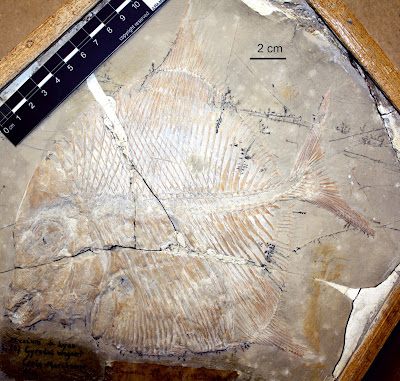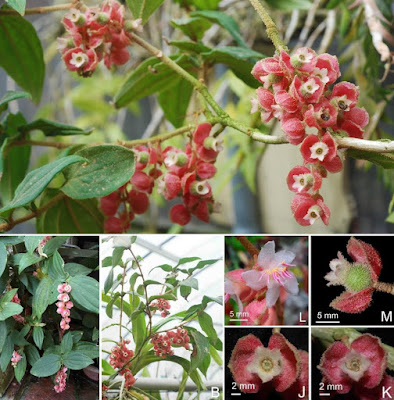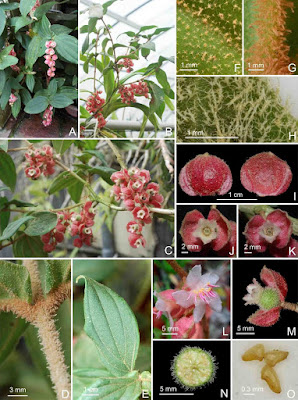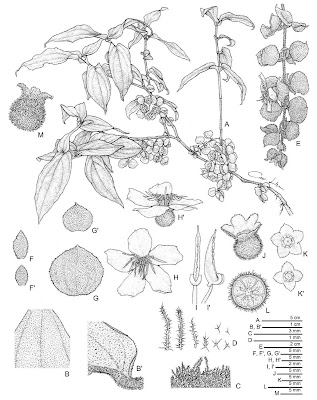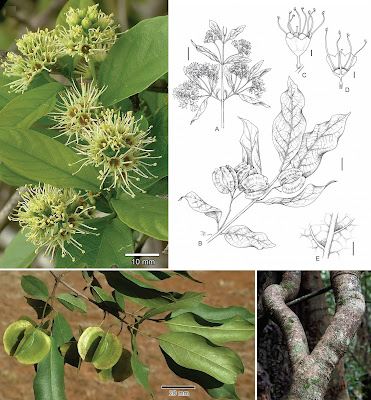[Most Recent Entries] [Calendar View]
Monday, February 24th, 2020
| Time | Event | ||||||
| 3:56a | [PaleoIchthyology • 2020] Thiollierepycnodus wagneri • A New Genus of Pycnodontidae (Actinopterygii) from the Upper Jurassic of France and Germany, included in A Phylogeny of Pycnodontiformes
Abstract The new genus Thiollierepycnodus is erected here to accommodate ‘Gyrodus’ wagneri or ‘Proscinetes’ wagneri, a taxon known since the 19th century from the marine Kimmeridgian Plattenkalk of Cerin (France) and since 2014 at the excavation site of the Naturkunde-Museum Bamberg in Wattendorf (Germany). Thiollierepycnodus is placed in Pycnodontidae (Upper Jurassic to Eocene), which is the most advanced family of Pycnodontiformes. With 154–152 Myr (Upper Jurassic), Thiollierepycnodus belongs to the stratigraphically oldest Pycnodontidae, still possessing some primitive features such as four incisiform teeth in the dentary, a crown of bifurcated anterior dentary teeth, reduced scale bars posterior to the dorsal fin origin, but the area of pterygiophores without scales and nine to 10 postanal ventral keel scales and approximately 10 complete scale rows posterior to the cloaca. A phylogenetic analysis leads to the placement of this taxon in Proscinetinae. This and the introduction of two additional taxa from the Cretaceous of Lebanon in the phylogeny are further steps to enlighten the broader evolutionary patterns of Pycnodontidae. Keywords: evolution, fossil fish, Kimmeridgian, Proscinetinae
Systematic palaeontology Actinopterygii Cope, 1872 Neopterygii Regan, 1923 Pycnodontiformes Berg, 1937 (sensu Nursall, 2010) Pycnodontoidei Nursall, 1996 (sensu Poyato-Ariza & Wenz, 2002) Pycnodontoidea Agassiz, 1833 (sensu Poyato-Ariza & Wenz, 2002) Pycnodontidae Agassiz, 1833 (sensu Nursall, 1996) Proscinetinae Poyato-Ariza & Wenz, 2002 Thiollierepycnodus Ebert, gen. nov. Etymology: The genus epithet refers to Victor Joseph de l’Isle Thiollière (1801–1859) who first recognized and described the species, plus the suffix pycnodus because Thiollière first assigned this species to the genus Pycnodus. Thiollierepycnodus wagneri (Thiollière, 1852), comb. nov. Pycnodus wagneri Thiollière, 1852: Thiollière, 1853: pl. 7, fig. 1; Thiollière, 1854: 23; Thiollière, 1873: 12. Microdon wagneri (Thiollière, 1852): Heckel, 1856: 201; Wagner, 1860: 396; Zittel, 1887: 247, fig. 258; Woodward, 1895: 225; Eastman, 1914: 368, pl. 53, figs 1, 2. Gyrodus wagneri (Thiollière, 1852): Saint-Seine, 1949: 127, pl. 13, fig. B, pl. 14, fig. B. Proscinetes? wagneri (Thiollière, 1852): Poyato-Ariza & Wenz, 2002: 151. Distribution: All specimens above are from the Plattenkalk of Cerin, France, except the specimen from the NKMB, which is from Wattendorf, Bavaria, Germany. Etymology: The specific epithet in Thiollierepycnodus wagneri refers to Dr Johannes Andreas Wagner 1797– 1861, who was professor of zoology at the university in Munich and conservator of the Zoologische Staatssammlung München, Germany. Type locality: Cerin, Ain, France. Type horizon: Upper Kimmeridgian up to the eigeltingense horizon of the Tithonian (lowest horizon of the Tithonian).
Martin Ebert. 2020. A New Genus of Pycnodontidae (Actinopterygii) from the Upper Jurassic of France and Germany, included in A Phylogeny of Pycnodontiformes. Zoological Journal of the Linnean Society. 188(2); 434–454. DOI: 10.1093/zoolinnean/zlz087 | ||||||
| 7:59a | [Botany • 2020] Medinilla vexillifer (Melastomataceae: Dissochaeteae) • An Elegant New Species from the Philippines
Abstract Medinilla vexillifer C.W. Lin & Rubite (Melastomataceae) from the Philippines is a new species described and illustrated. It most resembles M. calcicola Merr., but differs in its shorter petioles that are 0.2−0.8 (vs. 1−2) cm long, lanceolate to ovate (vs. obovate) leaf lamina, cordate (vs. acute to acuminate) leaf base, upper leaf surface that is densely covered with brownish-yellow stellate and dendroid trichomes (vs. glabrous leaf surfaces), terminal or axillary (vs. only axillary) inflorescences, to 15 (vs. 2−2.5) cm long, and 4- or 5-merous (vs. 5-merous) flowers. This exquisite species has hairy leaves and apendulous inflorescence with bright pink bracts and white petals. The bracts are long-persistent and last for about five months, which may result in its high horticultural potential. Keyword: Dissochaeteae, Medinilla, Melastomataceae, Luzon, new species, Philippines Medinilla vexillifer C.W. Lin & Rubite, sp. nov. Type: PHILIPPINES. Original locality not known; possibly from Luzon Island. Type specimen pressed from plants purchased from a floral market in Manila, Philippines and cultivated in a nursery in Taiwan, 25 Nov. 2018, C. W. Lin 676 (holotype PNH!; isotype SING!, TAIF!). Scandent multi-branched shrub up to 80 m long. Stem terete, internodes to 10 cm long, shorter on the distal branches; nodes rather thickened, knobby, with densely covered with brownish-yellow dendroid trichomes, glabrescent, bark becoming striate on older stems; young stems about 3 mm in diameter, green. Distribution and ecology: The exact collection locality of Medinilla vexillifer is unknown; according to Mr. Tan (pers, comm., 2018), the new species has been imported to the Singapore from Manila in 2013 so we assume it originated Luzon Island in the Philippines. Etymology: The specific epithet refers to the many colorful and pendeulous inflorescences, resembling countless flag. Che-Wei Lin and Rosario Rivera Rubite. 2020. Medinilla vexillifer (Melastomataceae: Dissochaeteae), An Elegant New Species from the Philippines. Taiwania. 65(2); 149-153. taiwania.ntu.edu.tw/abstract.php?type=ab | ||||||
| 10:23a | [Botany • 2020] Combretum eugeneanum • A New Species of Combretum Sect. Ciliatipetala (Combretaceae) from South Africa
Abstract Combretum eugeneanum, a new species from northeastern KwaZulu-Natal, South Africa and confined to the Maputaland Centre of Plant Endemism, is described, illustrated, mapped, and compared with southern African members of the genus with which it may be confused. In a narrowly defined genus Combretum, the new species belongs to Combretum sect. Ciliatipetala. In herbaria, it has usually been confused with close relatives C. apiculatum and C. edwardsii, as well as several other more distantly related members of the genus, in particular C. woodii. The new species is also closely related to the recently described C. stylesii. It is readily distinguished as an essentially glabrous woody climber or scrambling shrub needing other vegetation for support, leaf apices rarely apiculate, tertiary veins raised on the adaxial leaf surface, inflorescences few-flowered and subcapitate, upper hypanthium cupuliform, flowers with orange-red centres (discs) and peltate scales comprised of essentially eight radial cells, most of which are subdivided by at least one tangential wall, the resulting outer and inner cell(s) often with at least one additional radial wall. Combretum eugeneanum grows in Sand Forest and associated sandy bushveld, and its range and habitat does not overlap with that of C. edwardsii or C. stylesii, both of which are also very often lianas. Keywords: anatomy, Combretoideae, Combretum eugeneanum, endemism, Maputaland Centre of Endemism, peltate scales, scales, taxonomy, Eudicots Combretum eugeneanum R.G.C.Boon, Jordaan & A.E.van Wyk, sp. nov., Diagnosis:— Closely related to Combretum apiculatum, but easily distinguished from this species by being a scrambling shrub to woody climber (vs. usually a single-stemmed tree up to 8 m tall with a rounded canopy), leaf apex acute to obtuse, sometimes acuminate, very rarely apiculate (vs. leaf apex always apiculate), inflorescence a few-flowered subcapitate spike of up to 15(–16) flowers, flowers compactly arranged (vs. an elongated many-flowered spike with about 25 flowers), upper hypanthium cupuliform (vs. campanulate), fruit 18–20 × 22–24 mm (vs. 20–30 × 15–25 mm), and scales of 8 radially arranged cells with most of these cells usually subdivided by at least one tangential wall, the resulting outer and inner cell(s) often with at least one additional radial wall (vs. usually simple 8-celled). Also related to C. edwardsii and C. stylesii; all three being scramblers or climbers, but the range of C. eugeneanum does not overlap and habitat differs. Older growth of the new species is almost totally glabrous, whereas C. edwardsii and C. stylesiihave leaves, petioles and branchlets with dense hairs. Additionally, in C. edwardsii the red-brown scales are visible with the naked eye and the inflorescence is an elongated spike, whereas in C. eugeneanum the scales are invisible without magnification and the inflorescence is subcapitate. Etymology:— The specific epithet honours Eugene John Moll (1941– ), eminent South African plant ecologist and author of books on tree identification. He has undertaken vegetation studies in, amongst others, KwaZulu-Natal, where he has collected many herbarium specimens from Maputaland, several of which turned out to be new records, or new taxa (Glen & Germishuizen 2010). Common names:— Maputaland climbing bushwillow; maputalandrankboswilg (Afrikaans). Richard G.C. Boon, Marie Jordaan and Abraham E. van Wyk. 2020. A New Species of Combretum Sect. Ciliatipetala (Combretaceae) from South Africa. Phytotaxa. phytotaxa.434(1); 1–12. DOI: 10.11646/phytotaxa.434.1.1 |
| << Previous Day |
2020/02/24 [Calendar] |
Next Day >> |
